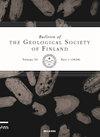Multiscale mapping and scaling analysis of the censored brittle structural framework within the crystalline bedrock of southern Finland
IF 1.3
4区 地球科学
Q2 GEOLOGY
引用次数: 2
Abstract
Fracture studies commonly lack data for the length range between 10 m to 1 km. For this reason, scaling laws are required to extrapolate fracture properties, for example in discrete fracture network models. This study focused on analysis and correlation of topology, orientation and length distribution of multiscale fracture datasets to assess their scalability. The used datasets comprise UAV-derived photogrammetric models from natural outcrops and lineaments mapped using airborne LiDAR, bathymetry and aerogeophysical data, in several contrasting scales and resolutions. This study highlights challenges in acquiring uncensored and coherent brittle structural datasets from source data characterized by a large span of resolutions between the remote sensing datasets and models of the fractured outcrop. In specific, collected data was found to be potentially biased and affected by uncertainties related to both the censoring by sedimentary cover and the scale of observation. Our results revealed differences between lineament and outcrop fracture orientations, as well as difficulties in assessing topological parameters from lineament datasets. The 1:200000 resolution was found best suited to the mapping of lineament length and resulted in a length distribution power law exponent of -1.92. For outcrop fractures that are less than 2 m long, the lognormal length distribution provided the only good fit to our data, while the longer outcrop fractures fitted relatively well with a power law exponent of -2.26.芬兰南部结晶基岩中截尾脆性结构框架的多尺度制图和尺度分析
裂缝研究通常缺乏10米至1公里长度范围内的数据。因此,需要使用尺度定律来推断裂缝性质,例如在离散裂缝网络模型中。本研究主要对多尺度裂缝数据集的拓扑、方位和长度分布进行分析和关联,以评估其可扩展性。使用的数据集包括利用机载激光雷达、测深和航空地球物理数据绘制的自然露头和轮廓的无人机衍生摄影测量模型,具有不同的比例尺和分辨率。本研究强调了从源数据中获取未删节的、连贯的脆性结构数据集的挑战,这些数据集的特征是遥感数据集和裂缝露头模型之间的分辨率跨度很大。具体而言,发现所收集的数据可能存在偏差,并受到与沉积覆盖和观测规模有关的不确定性的影响。我们的研究结果揭示了线状和露头裂缝方向之间的差异,以及从线状数据集中评估拓扑参数的困难。发现1:20万分辨率最适合于绘制线条长度,并导致长度分布幂律指数为-1.92。对于长度小于2 m的露头裂缝,对数正态长度分布与我们的数据只有很好的拟合,而较长的露头裂缝的幂律指数为-2.26。
本文章由计算机程序翻译,如有差异,请以英文原文为准。
求助全文
约1分钟内获得全文
求助全文
来源期刊
CiteScore
1.30
自引率
0.00%
发文量
5
审稿时长
>12 weeks
期刊介绍:
Bulletin of the Geological Society of Finland (BGSF) publishes research articles and short communications in all branches of geosciences. Contributions from outside Finland are welcome, provided that they contain material relevant to Finnish geology or are of general interest.

 求助内容:
求助内容: 应助结果提醒方式:
应助结果提醒方式:


